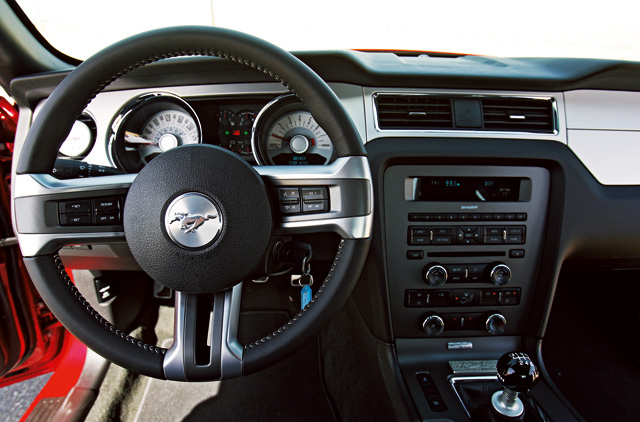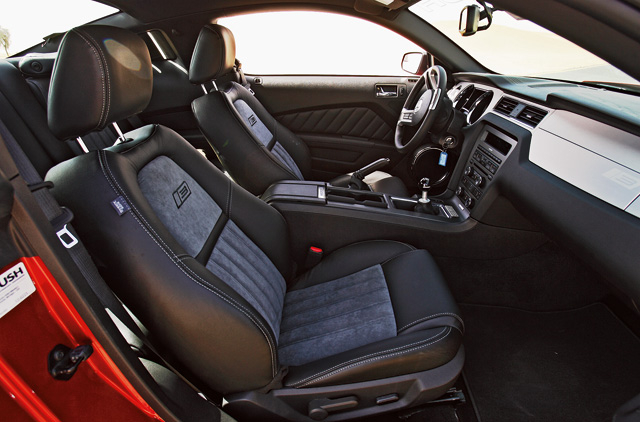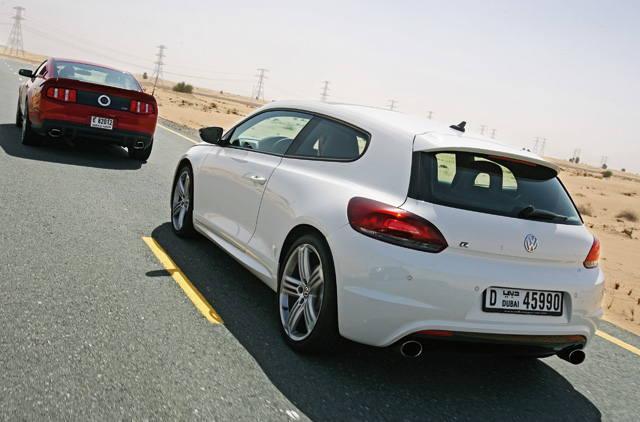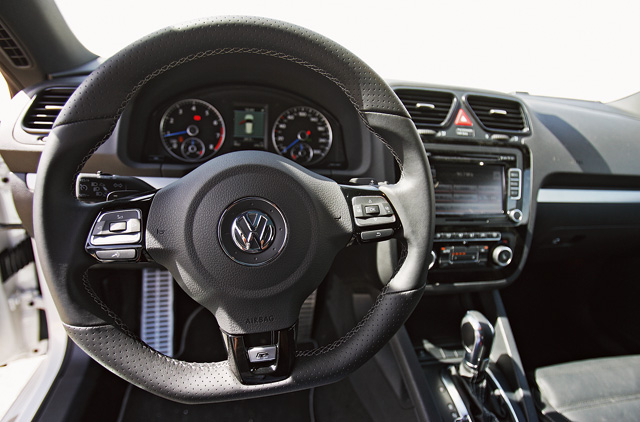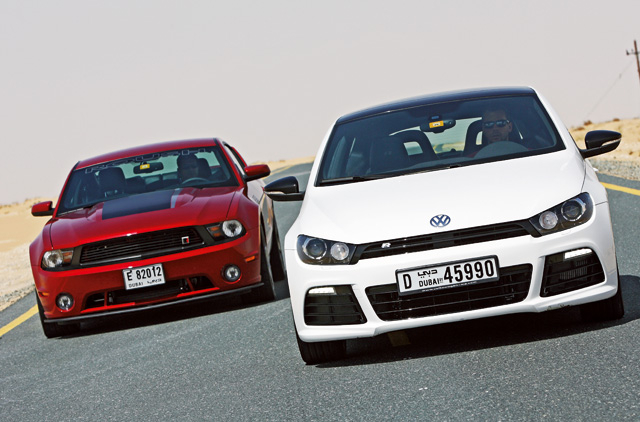
You don’t need 540 horsepower to have fun. Cars like the diminutive Suzuki Swift worth a staggering 99 horses are proof that even double digit figures can spread a smile on your face the size of Julia Roberts’ mouth on nitrous oxide.
But it does help if you do, in fact, have 540bhp. Today, we do. Although in that case, the fun factor may quickly metamorphose into the fear factor.
It’s all right though, because to bring us back down to earth after stumbling out of this supercharged tumble drier that they call the 2012 Roush Stage 3 Mustang, we also have an innocent Volkswagen at our disposal. Only, that one has 255 horsepower scrambling for freedom through the front-wheels alone, and we all know that’s a major bottleneck disaster just waiting to happen. Perhaps we didn’t think this through very well…
Or you can just cross your eyes a little bit, and see things from our clear perspective: these are two cars bursting at the seams with power, given their respective means of harnessing it. They are vastly different, but they approach the same problem, just from opposite ends, literally: one is front-wheel drive, and the other rear-wheel drive. The Scirocco R handles pretty much the upper limit of what a front-driver can control, and the Mustang just about manages to spare its rear tyres from a smoky death every time you kick the firewall.
Working with a 5.0-litre V8 that you find in any Mustang GT, Roush adds its own R2300 supercharger feeding 10psi of intercooled energy to spike the horsepower from the stock 412bhp to 540bhp. The Scirocco uses half the cylinders, and even less displacement, its preferred force-feeding method being turbocharging. The 2.0-litre TSI unit produces 255bhp in GCC-spec — slightly downtuned for our market — just like
it does in the Golf R, but that one is all-wheel drive.
To combat the kind of torque steer that sprains wrists, Volkswagen fitted the ‘Rocco R with something called XDS. That is an electronics-based system that brakes an inside wheel to reduce understeer, doing it with more complexity but less weight than a limited slip differential would. Only, an LSD does it a bit better.
There’s no torque vectoring or clever electronics in the Roush. You hold down
a button marked “switch me off if you have nothing to lose” and a light comes on to tell you that you’re clinically insane. You then thrust the eight-ball shifter into first, mash your foot into the carpet and row at the gear lever constantly as the Roush steams through a warping world.
Roush adds its own finely tuned suspension system to the stock GT, with Roush front struts, rear shocks, front and rear springs, front and rear stabiliser bars, jounce bumpers, and anti-wheel hop kit. The chassis consequently feels nice and stiff, but the live axle at the back ends up being quite toned down in a cruise; it’s fairly comfortable actually. Yet the car does lean in the corners, despite supremely grippy high-performance Cooper tyres. The steering is spongy — and the wheel itself clumsily spoked — rather than firm, but it offers a good link to the front wheels.
The Scirocco makes a similar mistake with its steering feel, using electronics to dial in a heavy and artificial feel not befitting a car that’s has a 100kg advantage over a Golf R. Instead of feeling light on its front feet, the Scirocco is a bit cumbersome to chuck into corners, whereas your common GTI would throw itself in with the sprightliness of a mosquito. Weirdly, our tester also doesn’t have Volkswagen’s excellent ACC chassis control system fitted, and with the optional 19in wheels and tyres fitted to the ‘Rocco, the ride quality is just cruel.
I’m convinced the smaller wheels package would make the Scirocco more communicative and supple to handle, but you can’t argue with the fact that with these oversized shoes it looks darn good. And anyway, if you just adjust your driving technique, the ‘Rocco R is an absolute blast. On paper, and perhaps in practice too, everything is telling you that the Scirocco rewards smooth inputs. But I found that — and Zlatko (see box page 30) will probably call me a moron here — driving the R using a totally different technique, namely, antagonistic violence, is more rewarding. Don’t shout at me Zlatko, but I was very smooth with the steering inputs, although my right foot was doing a pretty good Michael Flatley Lord of the Dance solo. Pumping the throttle and lifting off abruptly unsettles the lightweight car easily, and swings the tail out for the front end to tuck into the corner. I found that relying on that, quotation marks, limited slip differential, with a steady and smooth throttle input induces understeer more quickly than I’d like, and sooner than I experienced in the taller, heavier Golf R.
Don’t get me wrong though, because with 255bhp on tap and a low centre of gravity, coupled to a wide track, the Scirocco R still scythes through corners carrying loads of speed before either the tyres or your nerves give up. It’s a technically brilliant car, but not as involving for the driver as I expected.
The Mustang, too, begs for abuse. That’s probably where the similarity between these two cars ends. It has just the most perfect gearbox I can remember, because the Porsche GT3’s shift feel is now only a distant memory in my automatic-transmission-polluted mind. Surprisingly the clutch is tenderly light, with good action even if it does bite a bit high, but it’s nothing you don’t get used to after three standing starts. And standing starts in the Roush are great, because the liveaxle just plumps down and grips, leaving you to play a game of pool. You don’t so much shift gears with that eight-ball, as you punch them. But they aren’t swings or uppercuts, they’re precise jabs, right in the kisser. Bam, knockout, Bam, fourth, Bam, 250kph…
The gear-shift feel alone is good enough to put a smile on your face that will make your cheek muscles numb, but just as well that it’s accompanied by that demonic war cry emanating from the V8. Roush also, wisely, fits the 2012 Stage 3 Mustang
with four-piston, 14in brakes behind 20in wheels.
This is still a nose-heavy car (it’s just heavy, period), and it rakes under braking. You stop just fine in terms of distance, but the liveable suspension settings let the whole car nose dive, meaning the rear end gets light as all the weight flies forward, and the tail slithers across the road right up until you’ve just about stopped dead. It’s scary, almost as scary as the rabid, raging way this thing gallops forward.
It’s way more settled in the bends. The Roush immediately responds to throttle inputs, sloshing its weight across both axes with a lot of communication. It’s not exactly a scalpel, but a Rambo knife can get the job done too. It feels softer and more susceptible to mistakes when entering corners and settling in than the ’Rocco, but it actually stays planted all the way through, with a natural road-holding ability that seems to lack in the hot Volkswagen. That’s the difference between mechanical suspension tuning and electronic gadgetry, I guess.
Both are, in truth, sublime cars. The Volkswagen is a cut-price street terror that can stick to the back of the Roush all day long, but if you’re graduating from something like a Renaultsport Clio or a Golf GTI, don’t expect the same thrills. Just a lot more effectiveness. The Roush is a madman, in looks and demeanour, but once you accept that it won’t actually bite your head off — it only sounds like it will — it’s more relaxed to drive fast than the base ’Stang with 130bhp less. Two very different formulas and, surprise-surprise, two very different experiences.
Saif Hattawi — RWD expert
I love RWD, because they give me more freedom in terms of the driving style. If I want to slide the car, I do it with just one press of the throttle. Although driving RWD cars up to their limits is more challenging and requires more skill, it gives me direct steering feedback, especially on the track. RWD cars tend to oversteer, and they have the least advantage when it comes to slippery roads, but with today’s electronics that isn’t an issue.
Controlling the traction of the car is more challenging, but it’s more rewarding, and gives a great sense of achievement when done right. I feel more connected to the car and the road. The car responds to my steering inputs and feels lighter to control than FWD. Having the feeling of the car pushing me always puts a huge smile on my face, rather than feeling the car pulling from the front.
The throttle pedal is your friend and can be your enemy as well. Certain conditions require you to have a heavy foot, and others need feather-light pressure. Going into corners needs more attention than FWD cars as the tail tends to go out easily. Some RWD cars can tolerate late braking, and exiting a corner while flooring it will not help.
Limited slip differentials make a huge difference on FWD cars but help RWD cars as well. If you’re tracking your car you’d definitely need LSD regardless of the drive terrain you use.
If you’re starting out with RWD, my recommendation would be to take it easy and take it step by step. Slamming the throttle doesn’t always make you a good driver. The car needs to be controlled smoothly. You’ve got to tame the beast under the hood that spins the wheels. Suspension modification and adjustment can result in a very stable car whether it’s on the road or the track. Power is not always the answer to everything.
Zlatko Mulabegovic — FWD expert
I’ve been driving mostly FWD cars over the past two decades, both on the street and track, and I therefore have an idea on how to drive them in any given condition. FWD cars are the easiest to drive hard, since they naturally tend to understeer, giving the driver an early warning, clearly signalling when to back off. This doesn’t mean that FWD cars are foolproof, and they surely require certain techniques and skills in order to be driven fast in a safe manner.
I grew both fond and comfortable driving FWD cars hard, having learned the game through participation in autocross, sprints and circuit racing, knowing what to expect and how to make up for some of the shortcomings of this layout.
I know that every purist will swear by RWD and I do not disagree with that; they are the real deal. Yet driving FWD cars on the limit can be both as challenging and rewarding. In an FWD car the front wheels have the complex task of transferring the power to the tarmac, steering and braking, which requires a different driving approach when compared to the techniques for RWD. My recipe for fast-cornering in an FWD car is a combination of late braking, slow-in and fast-out approach. Due to the fact that a front-engined FWD car understeers heavily, there’s only so much speed you can carry into a corner without braking traction, therefore a clean approach nets better results than aggressive driving. Late braking transfers most of the weight forward, making the front tyres grip hard while the rear end goes lighter, inducing a tad of oversteer, which helps you aim for the apex and allows you to get back on the throttle earlier. Once the front wheels have enough traction, you can power out of the corner.
A limited slip diff makes a huge difference on FWD cars, taming the unwanted wheelspin and sending power to the wheel with more grip. This means that you are able to go harder on the throttle without excessive wheelspin. Slow-in and fast-out is the best advice I can give to anyone with a fast FWD car. I also advise stiffening the rear end with strut bars and thicker sway bars, which greatly improves the turn-in of an FWD car, making it safer and way more fun to drive.
Specs & ratings
- Model Roush Stage 3 Mustang
- Engine 5.0-litre V8 supercharged
- Transmission Six-speed manual, RWD
- Max power 540bhp @ NA
- Max torque 630Nm @ NA
- Top speed 260kph
- 0-100kph NA
- Price Dh260,000
Specs & ratings
- Model Scirocco R
- Engine 2.0-litre four-cyl turbo
- Transmission Six-speed auto, FWD
- Max power 255bhp @ 6,000rpm
- Max torque 350Nm @ 2,500rpm
- Top speed 250kph
- 0-100kph 6.0sec
- Price Dh160,000


